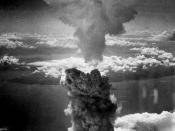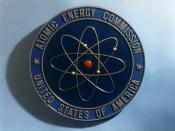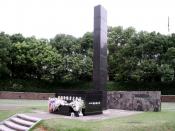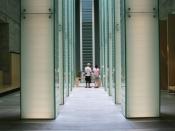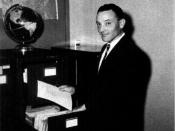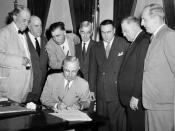How the Atom Bomb Was Developed The events leading to the development of the atom bomb began in 1896. In that year Henri Becquerel of France discovered radioactivity of certain atoms. Influenced by Becquerel's work, Marie and Pierre Curie discovered two naturally radioactive elements, radium, and polonium. Following this, many more important discoveries occurred.
In 1905 Albert Einstein of Germany advanced his famous theory E=mc2, which states that energy equals mass times the speed of light squared. This described what would happen if energy and matter could be changed into each other. Scientists calculated the energy of one single hydrogen nucleus has almost one billion electron volts. A New World of scientific investigation was opened by this theory. The atom was studied, measured, and full of nuclear particles.
The atom gave up its biggest secret in 1938 when Hahn and Strassmann of Germany learned that they had split the uranium atom.
Lise Meitner and O.R. Frisch identified the splitting as nuclear fission. Excitement was great in the scientific world. Each fission was found to release about 200,000,000 electron volts of energy. In addition, it was found that neutrons were thrown off in the fission process. These Could be used to set off a chain reaction of nuclear fissions. The next step could be a violent chain reaction-which would lead to the atomic bomb.
Many world scientists feared that Germany, which was at war, would develop the bomb and use it to conquer the world. Thus, a number of them presented facts about atomic energy to President Franklin D. Roosevelt in 1939. He created the Uranium Project to study atomic-bomb development. The President ordered increased effort late in 1941 when the United States entered World War II. Two noted Americans, Vannevar Bush, and James Conant then supervised the atomic bomb project. All activities of the project were kept secret.
Progress was made through 1942. A nuclear reactor was designed to sustain a chain reaction. The pile was first put into operation on December 2, 1942. On that historic day the Atomic age opened. A nuclear chain reaction had been achieved.
The United States War Department was brought into the work in 1942 when it appeared that an atomic bomb could be developed in time to be of use in World War II. In May 1943, the U.S. Army Engineers took complete charge of all activities related to the development of atomic energy and atomic bombs. The name of the project was changed to the Manhattan Engineer District. Major General Leslie R. Groves was appointed to direct the entire Project.
Huge Plants were built to speed up production of uranium 235 and plutonium. Plutonium, element 94, was manufactured in a nuclear reactor by the combination of U-238 with neutrons.
The biggest question off all, which everyone who knew about this was whether or not the bomb would work or not. To answer this, a laboratory had been built at Los Alamos, NM, near Santa Fe. A young physicist, J. Robert Oppenhimer, directed the laboratory. The test bomb was carefully put together on a desert near Alamogordo, NM. On July 16, 1945, scientists and Army officers witnessed from a safe distance the first atomic-bomb explosion. The light from the bomb was blinding. Heat and wind rushed out in all directions. The scientists later learned that the high steel tower on which the bomb was placed had disappeared into superheated vapor.
Three weeks later, on August 6, 1945 a United States warplane exploded an atomic bomb over Hiroshima, Japan. This city of about 343,000 population counted about 150,000 dead and injured after the explosion. This bomb contained uranium 235. Three days later plutonium 239 bomb was dropped on Nagasaki, Japan, a city of about 200,000 population. It was estimated that 79,000 were killed and injured. More than 67 percent of the buildings in Hiroshima were destroyed or damaged, and about 88 percent of those in Nagasaki.
At a distance of one mile from the center of the explosion, 35 percent of the inhabitants were killed. Closer to the center-about one-half mile away-85 percent died. Beyond a mile and a third, there were very few deaths. Some of theses people were killed by the blast itself-by being thrown down or by being hit with debris. The blazing flash of heat seared some. Others were victims of the deep flash of gamma rays, which persisted for a few seconds. Still others perished in fires, which resulted from form the disaster.
Buildings were completely destroyed or severely damaged up to one half a mile from the point on the earth beneath the bomb explosion, although some well-built structures weathered the blast with minor damage. At a distance of one mile, brick walls were cracked and houses collapsed. Light frame buildings at twice this distance were heavily damaged. The total area of destruction ranged from five to eight square miles, with the most serious damage within the innermost two square miles.
Many test bombs have been exploded since 1945. Two were exploded at Bikini, an atoll in the Pacific, in 1946. Three were exploded in 1948 at Eniwetok, a Pacific island used as a permanent testing ground by the U.S. Atomic Energy Commission. Four more were set off at the same site in 1951.
At Bikini, one bomb was exploded in the water of the lagoon. The explosion lifted over a million tons of water high into the air. Battleships were anchored in the lagoon to determine the amount of damage that would occur.
Various other tests have been made since that time, including atomic-weapons tests in Nevada and at Eniwetok. Some of these tests have been aimed at developing smaller atomic weapons. One such weapon is a shell for firing from a large-bore cannon. Combat troops joined in some of the atomic tests.
The atomic bomb was developed, and used very well. It was used in the destruction of Hiroshima, and Nagasaki. Both of these cities as I have said already were destroyed in the bombing of them. The United States would never had been able to go forth with the destruction of those cities if they had not had figured out the components of the atomic bomb, and all of its components inside of it. The United States used this idea of the bomb well, and it became very important in the history of the United States.
